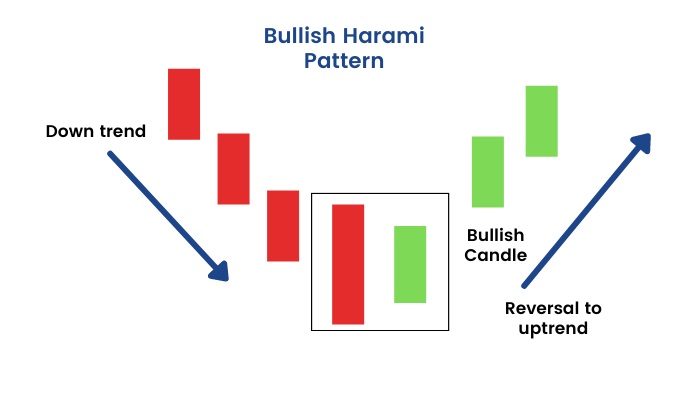Business
Understanding the Bullish Harami Pattern: A Guide for Traders

Trading can often be a daunting task, but recognizing specific patterns can provide essential insights for decision-making. One of these patterns is the Bullish Harami, a formation that frequently signals a shift in momentum. By identifying this pattern, traders can better navigate potential changes in market trends....Click to Read More
Technical analysis relies heavily on candlestick patterns to interpret market activity, and the Bullish Harami is a key player in this approach. This pattern’s ability to indicate a possible reversal from a downward trend makes it a valuable tool for traders seeking to capitalize on market shifts.
In this guide, we’ll dive deep into the bullish harami pattern, examining its structure, implications, and how it can be integrated into trading strategies. From identifying the pattern to effectively applying it, here’s everything you need to know.
How to Recognize the Bullish Harami Pattern
To successfully spot the Bullish Harami on a chart, traders must be attentive to several key details:
Identify a Downtrend: The presence of a Bullish Harami is more meaningful when it occurs after a sustained period of declining prices.
Observe the First Candle: The initial candle should be long and bearish, indicating strong selling activity.
Analyze the Second Candle: The second candle must be smaller, bullish, and entirely contained within the body of the first candle. This shift demonstrates a potential pause or reversal in the downward trend.
Spotting this pattern requires practice, but with experience, traders can become adept at recognizing it and using it to their advantage.
Implications of the Bullish Harami for Market Participants
The Bullish Harami pattern signals a potential change in market dynamics, suggesting that sellers are losing dominance and buyers may soon take over. This shift is crucial for traders seeking to identify entry points for long positions, as it often marks the early stages of a bullish trend reversal.
One of the advantages of using this pattern is that it offers a relatively low-risk entry point. Traders can place stop-loss orders just below the lowest point of the first candle, thereby limiting potential losses if the market doesn’t reverse as anticipated. It’s important, however, to wait for confirmation—such as increased trading volume or additional bullish signals—before making any trading decisions based solely on the Bullish Harami.
Incorporating the Bullish Harami into Your Trading Plan
Integrating the Bullish Harami into a comprehensive trading strategy can be highly effective. Here’s how to utilize this pattern for maximum impact:
Entry Signals: Traders should consider initiating positions when the Bullish Harami pattern appears, especially when confirmed by other indicators or chart patterns. This confirmation helps validate the potential reversal.
Setting Stop-Loss and Target Levels: Place stop-loss orders below the low of the first candle to manage risk. For take-profit targets, monitor resistance levels or use trailing stops to maximize gains as the trend progresses.
Combining with Other Indicators: For increased accuracy, combine the Bullish Harami with indicators like moving averages, RSI, or MACD. This will help confirm the strength of the potential reversal and improve decision-making.
Real-World Examples of the Bullish Harami Pattern
The Bullish Harami has proven effective in numerous real-world trading scenarios. For example, during a downturn in the stock market, this pattern often preceded a sharp rally, providing an early signal for traders to enter long positions. Similarly, in forex trading, the Bullish Harami has accurately predicted upward reversals in currency pairs, such as USD/JPY and EUR/USD, demonstrating its versatility across different asset classes.
These examples highlight the importance of recognizing and acting on the Bullish Harami pattern, as it can offer valuable trading opportunities.
Challenges and Limitations of Using the Bullish Harami
Despite its usefulness, the Bullish Harami is not without its challenges. One of the most common pitfalls is mistaking this pattern for a genuine reversal signal in volatile markets. False signals can lead to premature trades, resulting in unnecessary losses.
Additionally, over-relying on this pattern without considering broader market trends or additional analysis can be detrimental. Always incorporate other technical and fundamental indicators to validate the signal before making trading decisions. Lastly, trading psychology plays a vital role—patience and discipline are essential to avoid falling into traps set by false patterns.
Advice for Beginners Learning the Bullish Harami
For traders just starting, mastering the Bullish Harami can be a game-changer. Here’s some advice:
Start with Demo Accounts: Practice spotting the Bullish Harami in a demo trading environment to build familiarity and confidence without risking real money.
Expand Your Knowledge: Don’t limit yourself to just the Bullish Harami. Study other candlestick patterns and indicators to develop a comprehensive trading strategy.
Stay Informed: Continuously monitor market news and developments, as external factors can influence the effectiveness of the Bullish Harami.
Conclusion
The Bullish Harami pattern is a valuable tool that traders can use to identify potential reversals in bearish trends, offering insights into the changing dynamics of buyer and seller dominance. However, it should not be used in isolation. When combined with other technical tools and analysis, the Bullish Harami can significantly enhance your trading strategy and decision-making process.
By understanding the nuances of this pattern and integrating it into your trading toolkit, you can better navigate the complexities of the market and seize opportunities as they arise.

-

 Health2 days ago
Health2 days ago5 Signs That May Indicate Kidney Health Concerns
-

 Health2 days ago
Health2 days ago5 signs you ‘may’ be deficient of vitamin B12
-

 Health2 days ago
Health2 days ago3 things that can actually really prevent cancer
-

 Health2 days ago
Health2 days ago10 Things You Don’t Know About Stomach Ulcers
-

 Health2 days ago
Health2 days ago10 Ways You Can Train Your Brain To Remember Almost Anything
-

 Health2 days ago
Health2 days agoIncredible Health Benefits of Bitter Leaf
-

 Latest News3 days ago
Latest News3 days agoBREAKING: Coming To America’ actor John Amos is dead
-

 Health2 days ago
Health2 days agoWhy You Should Consider Drinking A Cup Of Tumeric Water Every Morning



